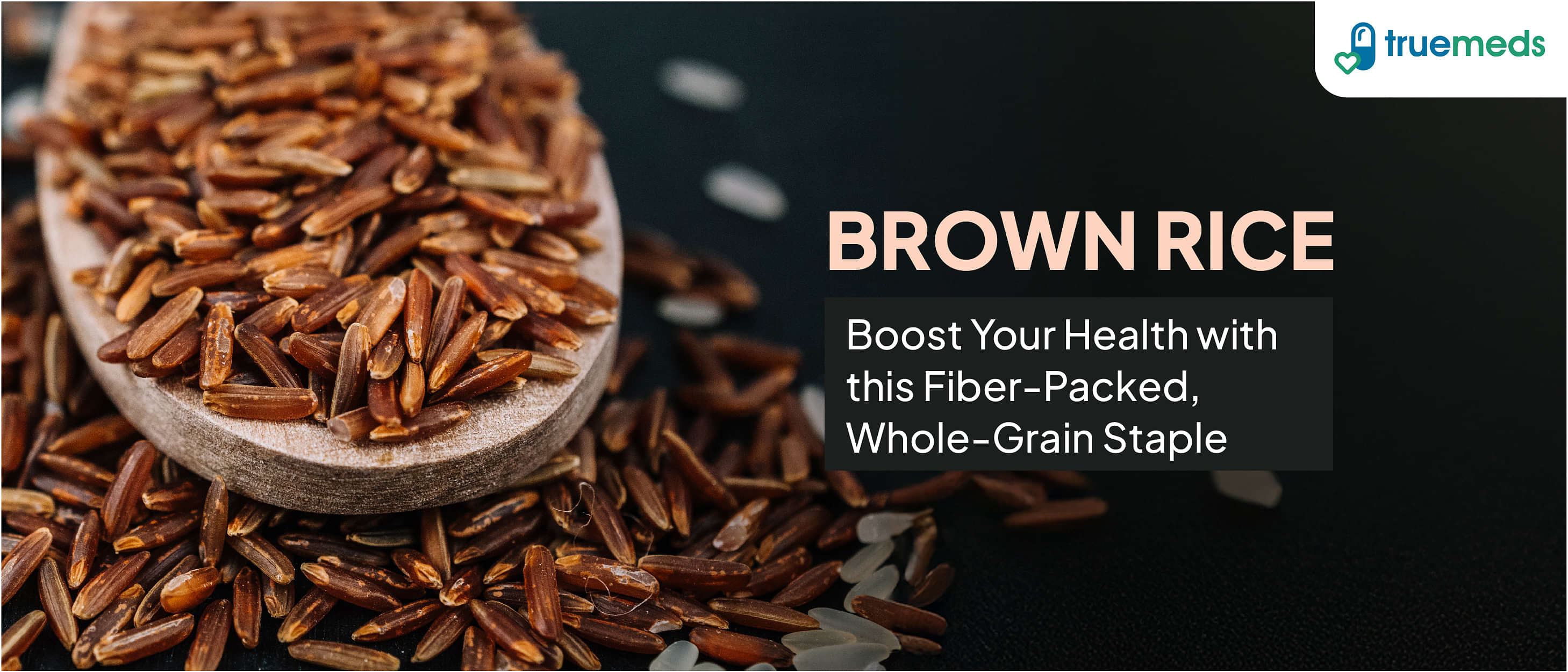Top 9 Amazing Health Benefits Of Brown Rice
Last updated on : 12 Mar, 2025
Read time : 9 min
Introduction
The simple act of replacing white rice with brown rice in our meals can bring about significant health benefits. Why so? Well, brown rice is a nutrient-packed superfood. Unlike white rice, it retains the bran and germ layers, which are home to a wealth of essential nutrients.
This whole grain is packed with vitamins and minerals. It also offers many health benefits that can improve your overall well-being. These advantages of brown rice make it a healthier choice compared to its white counterpart. In this blog, we will share the top seven amazing health benefits of brown rice. By the end, you’ll understand why this superfood deserves a spot on your menu.
What Is Brown Rice?
Brown rice, often known as the healthier counterpart of white rice, is a whole-grain rice variant. The process of its creation involves removing the inedible outer hull. This results in the brown or tan colour we associate with this type of rice. The bran and germ layers stay in brown rice, unlike white rice, which has these layers removed.
The advantage of brown rice is that it retains the bran, germ, and endosperm from the seed of the rice plant. This means that it contains higher amounts of fibre, unsaturated fatty acids, protein, minerals, vitamins, and starch than white rice. Therefore, daily consumption of brown rice can be highly beneficial for your health. If you’re questioning: “Can we eat brown rice daily?” Yes, it’s safe and even advantageous to include brown rice in your everyday diet!
The Nutritional Profile of Brown Rice
Understanding why brown rice benefits our health becomes clearer when we look into its nutritional profile. A single cup of cooked long-grain brown rice contains:
| Nutrient | Amount per 1 cup (195g) | % Daily Value (DV) |
| Calories | 218 | 11% |
| Total Fat | 1.6 g | 2% |
| Saturated Fat | 0.32 g | 2% |
| Trans Fat | 0 g | – |
| Cholesterol | 0 mg | 0% |
| Sodium | 2 mg | 0% |
| Total Carbohydrates | 45.8 g | 17% |
| Dietary Fiber | 3.5 g | 13% |
| Protein | 4.5 g | 9% |
| Calcium | 19.5 mg | 2% |
| Iron | 1 mg | 6% |
| Magnesium | 85.8 mg | 20% |
| Phosphorus | 150.2 mg | 12% |
| Potassium | 154 mg | 3% |
| Zinc | 1.2 mg | 11% |
| Copper | 0.16 mg | 18% |
| Manganese | 2.1 mg | 86% |
| Selenium | 19.1 mcg | 27% |
In addition, brown rice is also a good source of folate, riboflavin (B2), potassium and calcium. It’s exceptionally high in manganese, a mineral vital for many important processes in the body. Brown rice is recognised for its higher fibre content and essential minerals than white rice. This makes it a healthier choice for many diets.
Health Benefits of Brown Rice
Brown rice offers a wealth of health benefits, making it a superior choice for those looking to enhance their diet. Packed with essential nutrients, this whole grain supports various aspects of well-being, from heart health to digestive function. Let’s check some of the health benefits of eating brown rice:
1. Helps in Weight Loss
Among the many benefits of eating brown rice, its potential to assist weight loss is one of the most appreciated. Brown rice is a nutrient-dense whole grain that can contribute significantly to a healthy weight-management plan. Its high fibre content promotes feelings of fullness, helping to control hunger and reduce overall calorie intake. Including brown rice in your daily meals can thus effectively support your weight loss or weight maintenance goals.
2. Controls Blood Sugar Level
One of the key advantages of brown rice is its role in controlling blood sugar levels. Unlike refined grains such as white rice, brown rice has a lower glycemic index. This means that it does not cause a quick spike in blood sugar levels after consumption. The complex carbohydrates and fibre in brown rice help regulate blood sugar levels. This makes it a suitable option for individuals with diabetes or those aiming to manage their glucose levels.
3. Aids Digestion
Brown rice aids digestion remarkably well. It is rich in fibre which helps to bulk up the stool and move it along the digestive tract. The fibre in brown rice promotes bowel regularity and simultaneously helps maintain a healthy weight. This results in feelings of fullness and reduces the risk of overeating.
4. Controls Cholesterol Levels
The many advantages of brown rice also include its potential to control cholesterol levels. The fibre, antioxidants, and phytochemicals found in brown rice have been associated with a reduced risk of heart disease. Regular brown rice consumption may help lower cholesterol levels, regulate blood pressure, and improve overall heart health.
5. Neuroprotective Effect
Have you ever heard about the neuroprotective effects of brown rice? Brown rice is among other brown rice benefits, it has a neuroprotective effect. Brown rice is rich in gamma-aminobutyric acid which helps prevent various types of neurodegenerative diseases such as Alzheimer’s disease. It even helps by inhibiting a harmful enzyme known as protylendopeptidase, which is directly linked with Alzheimer’s disease.
6. Improves Maternal Health
Brown rice also improves maternal health. It helps to lower the sense of fatigue, depression, and mood swings in women who are breastfeeding. Additionally, it enhances immunity to infections and diseases during this period. This proves that the benefits of eating brown rice extend beyond basic nutrition.
7. Maintains Bone Health
Last but not least, brown rice maintains bone health. It is filled with magnesium which can improve the health of your bones and teeth. Furthermore, the ferulic acid present in brown rice contains anti-ageing elements that can keep you looking youthful!
8. Improved Heart Health
Brown rice is packed with essential nutrients that support heart health. It is rich in dietary fiber, which has been linked to a lower risk of heart disease-related mortality. Additionally, its high magnesium content helps protect against heart disease and stroke. Research shows that increasing whole grain intake, including brown rice, may reduce heart disease risk by 22% and the likelihood of stroke by 12%.
9. Reduced Risk of Diabetes
Brown rice has a low glycemic index (GI), meaning it helps maintain stable blood sugar levels after eating. Research suggests that consuming three servings of whole grains, like brown rice, daily can lower the risk of type 2 diabetes by up to 32%. In contrast, white rice has a higher GI and may increase diabetes risk. Studies indicate that frequent white rice consumption raises diabetes risk by 17%. Replacing just 50 grams of white rice per day with brown rice can potentially reduce this risk by 16%.
Brown Rice vs White Rice
When deciding between brown rice and white rice, it’s important to consider their distinct nutritional profiles and health benefits. While both are popular staples, they differ significantly in their nutrient content and effects on overall wellness. Let’s check how brown rice differs in various aspects as compared to white rice in the table below:
| Aspect | Brown Rice | White Rice |
|---|---|---|
| Nutritional Content | Retains bran and germ; high in fibre (3.5 g per cup), vitamins (e.g., B vitamins), minerals (e.g., magnesium, phosphorus); contains healthy fats and antioxidants. | Stripped of bran and germ; lower in fibre (0.6 g per cup); vitamins and minerals added back during enrichment; fewer antioxidants and healthy fats. |
| Glycemic Index (GI) | Lower GI (approx. 50); helps manage blood sugar levels and provides stable energy. | Higher GI (up to 89); leads to quicker spikes in blood sugar and less stable energy levels. |
| Digestive Health | Higher fibre content promotes regular bowel movements, aids digestion, prevents constipation, and supports a healthy gut microbiome. | Lower in fibre; may not support digestive health as well; can be easier on digestion for some but less beneficial for gut health. |
| Flavour and Texture | A chewy texture with a nutty flavor; adds depth to dishes. | Softer texture with a milder flavour; often preferred in a wider range of culinary applications. |
| Preparation Time | Longer cooking time due to whole grain nature. | Cooks faster and is more convenient for quick meals. |
| Shelf Life | Shorter shelf life; natural oils in bran and germ can go rancid. | Longer shelf life; more stable for long-term storage as it has been stripped of oils. |
Adding brown rice to your meals for its health benefits can support your nutritional needs and weight management goals.
Conclusion
If you’re choosing between brown and white rice for health reasons, brown rice is the better option. It offers more fibre, and essential nutrients, and has a lower glycemic index. This makes it beneficial for managing blood sugar and supporting digestive health. However, white rice has its advantages, such as being easier to digest and quicker to cook. It also provides a comforting, familiar taste. Both types of rice can be part of a balanced diet. Mixing them can add variety to your meals while still reaping the benefits of each. Try incorporating brown rice into your diet and enjoy its health benefits!
FAQs
Brown rice benefits health by providing vital nutrients like fibre, vitamins, and minerals. It promotes weight loss and heart health.
Yes, daily consumption of brown rice is beneficial for health as it’s a rich source of complex carbohydrates and aids in digestion.
Organic brown rice is preferably better. Being grown without harmful pesticides, it provides the advantages of brown rice without potential chemical residue.
In Ayurveda, brown rice is recommended for its balancing properties. It nourishes the body tissues, stabilises blood sugar levels and promotes mental clarity.
Yes, brown rice is great for weight loss as it is high in fiber, which keeps you full for longer and reduces overall calorie intake. Its complex carbohydrates provide sustained energy, preventing sudden hunger cravings. Additionally, it helps regulate metabolism and supports healthy digestion.
Brown rice is healthier than white rice because it retains the bran and germ, making it richer in fiber, vitamins, and minerals. It has a lower glycemic index, which helps stabilize blood sugar levels. Additionally, it provides more antioxidants and essential nutrients than processed white rice.
Yes, brown rice is beneficial for fatty liver as it is a whole grain with high fiber content, which aids in reducing fat accumulation in the liver. It also has antioxidants and essential nutrients that support liver detoxification. Choosing brown rice over refined grains can help improve overall liver health.
Disclaimer
Our healthcare experts have carefully reviewed and compiled the information presented here to ensure accuracy and trustworthiness. It is important to note that this information serves as a general overview of the topic and is for informational purposes only. It is not intended to diagnose, prevent, or cure any health problem. This page does not establish a doctor-patient relationship, nor does it replace the advice or consultation of a registered medical practitioner. We recommend seeking guidance from your registered medical practitioner for any questions or concerns regarding your medical condition.
Popular Articles
Recommended Articles
Recent Articles
Top-Selling Medicines:
...View more
Top-Selling OTC:
...View more
Subscribe
Registered Office Address
Grievance Officer
Download Truemeds

Contact Us
Our customer representative team is available 7 days a week from 9 am - 9 pm.
v3.7.5
Our Payment Partners


























































